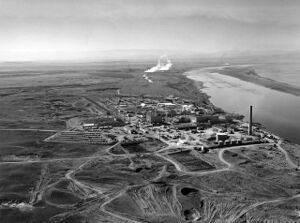Hanford Site (nonfiction): Difference between revisions
(Created page with "File:Hanford_Site.jpg|thumb|Nuclear reactors line the riverbank at the Hanford Site along the Columbia River in January 1960. The N Reactor is in the foreground, with the tw...") |
|||
| Line 14: | Line 14: | ||
<gallery> | <gallery> | ||
File:Ultravore.jpg|link=Ultravore|Synthetic organism [[Ultravore]] begins consuming radioactive chemical waste at the Hanford Site. | |||
</gallery> | </gallery> | ||
Latest revision as of 17:13, 2 July 2017
The Hanford Site is a mostly decommissioned nuclear production complex operated by the United States federal government on the Columbia River in the U.S. state of Washington. The site has been known by many names, including: Hanford Project, Hanford Works, Hanford Engineer Works and Hanford Nuclear Reservation.
Established in 1943 as part of the Manhattan Project in Hanford, south-central Washington, the site was home to the B Reactor, the first full-scale plutonium production reactor in the world. Plutonium manufactured at the site was used in the first nuclear bomb, tested at the Trinity site, and in Fat Man, the bomb detonated over Nagasaki, Japan.
During the Cold War, the project expanded to include nine nuclear reactors and five large plutonium processing complexes, which produced plutonium for most of the more than 60,000 weapons built for the U.S. nuclear arsenal. Nuclear technology developed rapidly during this period, and Hanford scientists produced major technological achievements. Many early safety procedures and waste disposal practices were inadequate, and government documents have confirmed that Hanford's operations released significant amounts of radioactive materials into the air and the Columbia River.
The weapons production reactors were decommissioned at the end of the Cold War, and decades of manufacturing left behind 53 million US gallons (200,000 m3) of high-level radioactive waste stored within 177 storage tanks, an additional 25 million cubic feet (710,000 m3) of solid radioactive waste, and 200 square miles (520 km2) of contaminated groundwater beneath the site. In 2011, the federal agency charged with overseeing the site, the US Department of Energy (DOE), emptied 149 single-shell tanks by pumping nearly all of the liquid waste out into 28 newer double-shell tanks. DOE later found water intruding into at least 14 single-shell tanks and that one of them had been leaking about 640 US gallons (2,400 l; 530 imp gal) per year into the ground since about 2010. In 2012, DOE discovered a leak also from a double-shell tank caused by construction flaws and corrosion in the bottom, and that 12 double-shell tanks have similar construction flaws. Since then, DOE changed to monitoring single-shell tanks monthly and double-shell tanks every 3 years, and also changed monitoring methods. In March 2014, DOE announced further delays in the construction of the Waste Treatment Plant, which will affect the schedule for removing waste from the tanks. Intermittent discoveries of undocumented contamination have slowed the pace and raised the cost of cleanup.
In 2007, the Hanford site represented two-thirds of the nation's high-level radioactive waste by volume. Hanford is currently the most contaminated nuclear site in the United States and is the focus of the nation's largest environmental cleanup. Besides the cleanup project, Hanford also hosts a commercial nuclear power plant, the Columbia Generating Station, and various centers for scientific research and development, such as the Pacific Northwest National Laboratory and the LIGO Hanford Observatory.
On November 10, 2015, it was designated as part of the Manhattan Project National Historical Park alongside other sites in Oak Ridge and Los Alamos.
In the News
Synthetic organism Ultravore begins consuming radioactive chemical waste at the Hanford Site.
Fiction cross-reference
Nonfiction cross-reference
External links:
- Hanford Site @ Wikipedia

